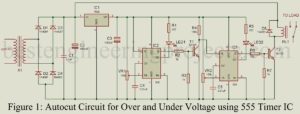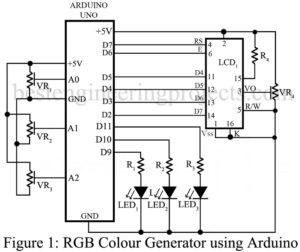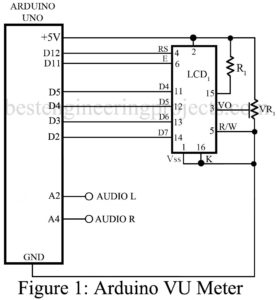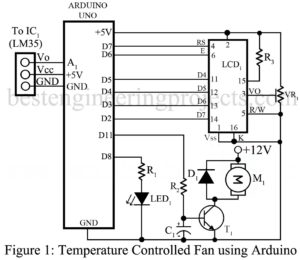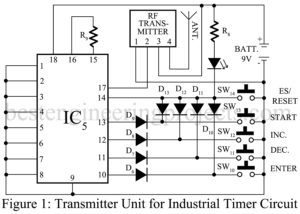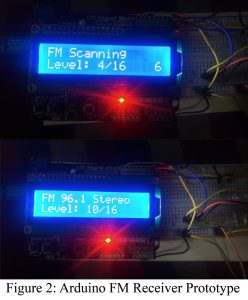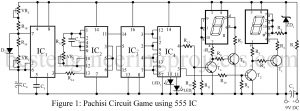The project “Auto Cut Circuit for Over and Under Voltage” is designed to protect electrical and electronic devices from over and under voltage which ensures a long lifespan of this device. An “Auto Cut Circuit for Over and Under Voltage” has been presented here serving multiple purposes for security; under-voltage protection, over-voltage protection, auto reset, auto cut off, and regulation. Circuit Description of Auto Cut Circuit for Over and Under Voltage The circuit diagram of “Auto Cut Circuit for Over and Under Voltage” is shown in figure 1. The entire…
Read MoreCategory: Electronics Projects
Dark Sensor using Arduino
The project ‘Dark Sensor using Arduino’ uses an arduino board, a LDR and switching circuit. The circuit is basically a light operated circuit which operates when dark is detected on LDR. Circuit Diagram of Dark Sensor using Arduino. Circuit diagram of the projects ‘Dark Sensor using Arduino’ is shown in figure 1, build around a arduino uno board, a LDR, three transistors and few other electronics components. The LDR is basically a transducer which change one form of energy to another form (change in light intensity to change in resistance).…
Read MoreRGB Colour Generator using Arduino
Basically, RGB represent three basic colour RED GREEN and BLUE which is used in our digital system for generation various other colour. The project ‘RGB Colour Generator using Arduino’ is basically a tutorial on how to generate colour code and hex code of that color. Circuit Description of RGB Colour Generator using Arduino The circuit of RGB colour generating using arduino is basically designed using a microcontroller unit (Arduino uno), a 16×2 alpha numeric LCD, a RGB LED and few resistor and variable resistor. The circuit diagram is shown in…
Read MoreSoil Moisture Meter using Arduino
The project ‘Soil Moisture Meter using Arduino’ uses arduino board, a 16×2 LCD module and soil moisture sensor in order to display the humidity (moisture) of soil. This project is very useful for farmer, floriculture, researchers etc. in order to know the moisture of soil at different stage. The working principle and circuit description is very simple that anymore can understand who have little knowledge of arduino board. The project is basically an interfacing circuit between arduino board with LCD and sensor. Previously, we had posted Greenhouse Automation System for easy, cost effective,…
Read MoreArduino VU Meter
The project ‘Arduino VU Meter’ uses 16×2 alphanumeric LCD to display signal level of audio. Basically, VU Meter is used to represent volume of audio equipment. Previously we had posted a project Sound VU Meter using Arduino which uses LEDs to represent the level of volume where audio is taken from microphone. Unlike sound VU meter using arduino the project Arduino VU meter take input audio from two different channels i.e. left channel and right channel. Circuit Description of Arduino VU Meter The circuit of Arduino VU Meter is shown…
Read MoreTemperature Controlled Fan using Arduino
The project ‘Temperature Controlled Fan using Arduino is simply fabricated around Arduino uno board and temperature sensor LM35. The projects are a good example of embedded systems designed using a closed-looped feedback control system. For proper user interface visual indication we had also used LCD which indicate the temperature as well as the speed of the fan. Circuit Description of Temperature Controlled Fan using Arduino The entire circuit of ‘Temperature Controlled Fan using Arduino’ utilizes very few components, an MCU (Arduino Uno), a temperature sensor (LM35), an LCD, a motor…
Read MoreIndustrial Timer Circuit
Humans are born of habits, they want more and more comfort. To match their requirements, various types of automatic control systems have been developed. Now, again here we have come up with a very interesting project called “Industrial Timer Circuit” with facilities like automation and switching, providing delay and having a long-range of control (100 m). A simple timer circuit can be designed using 555 timer IC by configuring it into monostable mode. These types of circuits have various types of limitations like digital display, an indication of system failure, remote…
Read MoreArduino FM Receiver Circuit using TEA5767
The circuit posted here is of Arduino FM Receiver using digital radio—receiver module TEA5657 by Philips. Additional components like audio power amplifier, Arduino uno board, and LCD module to display station number and frequency. However, for the receiving system to function flawlessly, external components like a capacitor, resistor, etc are included in the circuit, which is necessary. if you wish to make your FM transmitter circuit using Arduino please go through this link: Arduino FM Transmitter Description Arduino FM Receiver Circuit using TEA5767 The circuit of the project Arduino FM…
Read MorePachisi Circuit Game using 555 IC
Pachisi game is a game similar to backgammon played mostly in Indian subcontinent, in which cones and cowries shells are used instead of counter and Dice. The game is played on a board between two persons, with the pieces moved in accordance with the throws of the cones or cowrie shells. This is an interesting game to test the ‘frustration quotient’ of the players. The rectangular board includes a number of red and green circles. Opponents start from the same square and move in opposite directions. The player who reaches…
Read MoreAuto Cut for Manual Stabilisers using 741 IC
Ever plugged in an old appliance and watched the voltage dance like a leaf in the wind? Power fluctuations are the silent villains of electronics. One moment, your device is sipping power like a fine tea, the next—it’s drowning. This is where an Auto Cut for Manual Stabilisers comes in, acting like a vigilant gatekeeper, ensuring nothing goes out of control. The Problem with Basic Circuits Most existing circuits rely on transistors and zener diodes for sensing. Sounds simple, but they come with a pair of stubborn issues: Spurious triggering…
Read More